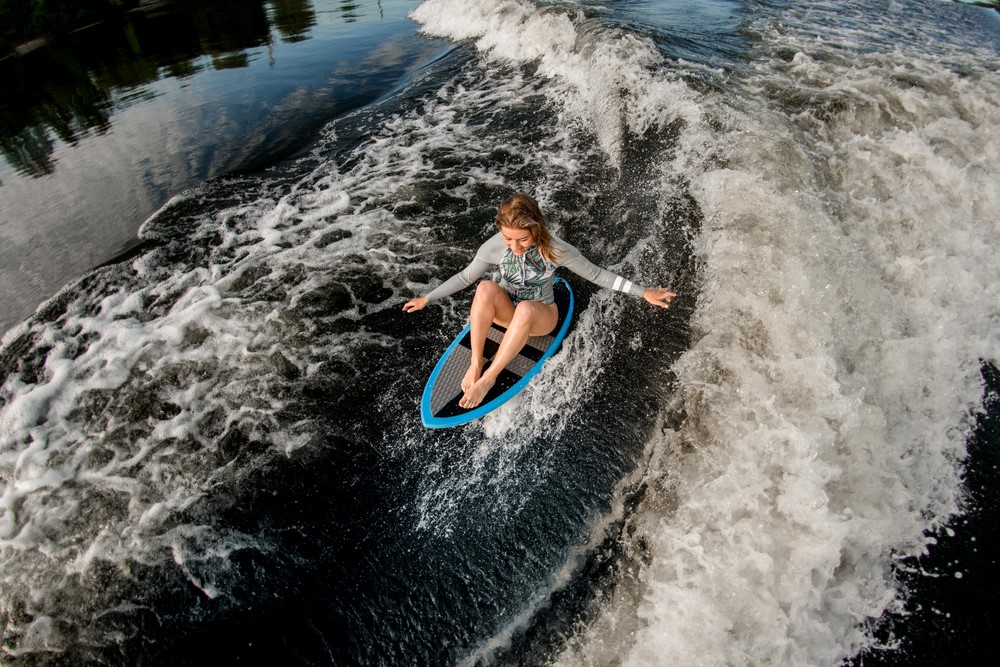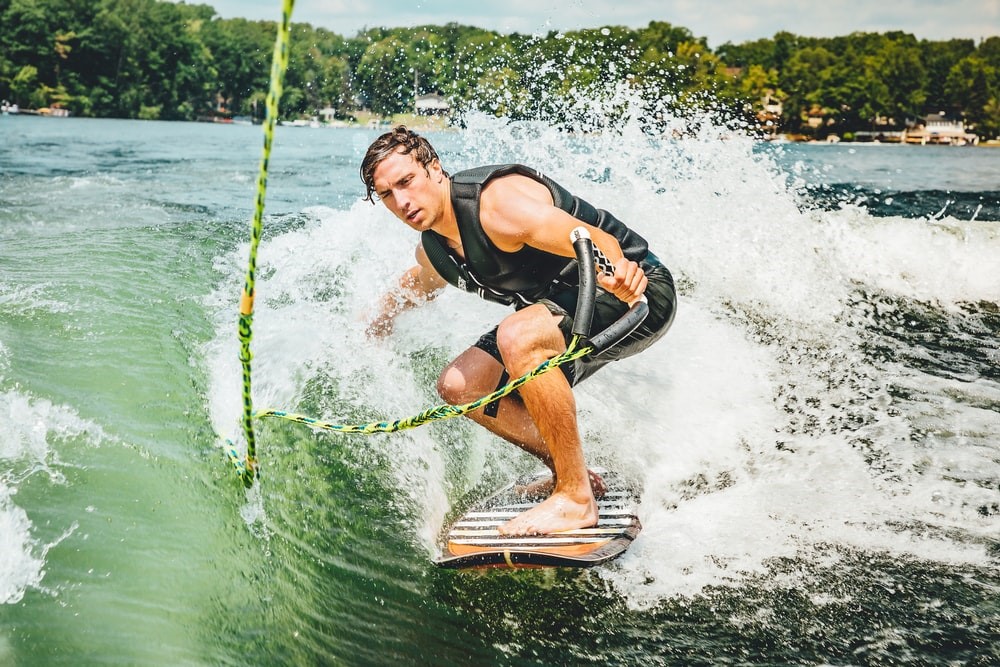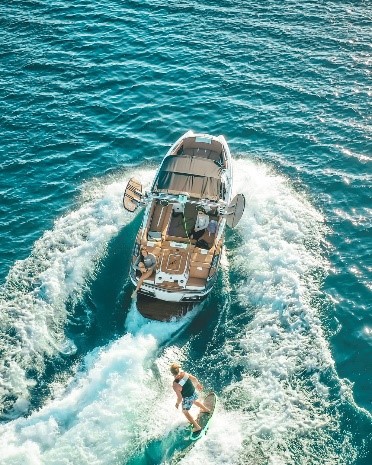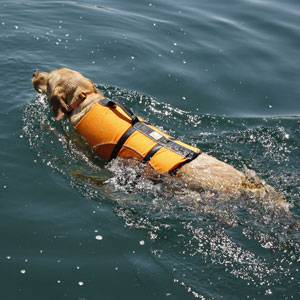Wakesurfing becomes more popular each year and is consistently gaining traction over wakeboarding – you can tell because wakesurfing gear sales are on the rise while wakeboarding gear sales are declining. More people choose to surf behind a boat and swap their wakeboard for a skim-style board or wake surfboard. So, why is wakeboarding vs wakesurfing such a big decision? How is wakesurfing different than wakeboarding? Is it easier for beginners to learn? Is it more fun?

You get towed by a boat at high speeds with a rope while getting air and wake jumping when you wakeboard.
When you wakesurf, you’re surfing the waves created by the boat without holding onto a rope. It’s similar to ocean surfing because you need to pump for speed on your surfboard to ride the pockets of the wave.
Skim-style wakesurfing includes air tricks and jumps, but it still doesn’t involve a rope as wakeboarding does. Surf style wakesurfing is like ocean surfing with similar maneuvers such as snapbacks, off-the-lips, and bottom and top turns.
The table below will recap the main differences between wakeboarding vs wakesurfing:
|
|
Wakesurfing |
Wakeboarding |
|
Main Goal |
Surf the waves behind the boat and pump to gain speed | Fast turns, wake jumping, getting air |
| Conditions | Works great in most conditions |
Best with glassy water |
|
Launch |
Harder – prone to towing or water start | Easier – water start |
|
Speed |
Low: 10-15mph |
High: 15-30mph |
| Rope | Only for getting up into the waves |
Towed by your boat all the time |
|
Boat |
V-drive or inboard, for big wakes: heavy ballasts | Outboard, inbound, or I/O, for elevation on the rope, a rope tow is needed |
| Gear | Skin style wakesurf board or surf style board |
Twin shaped wakeboard with bindings and small fins |
|
Injury Risk |
Low: Subtle shifts, unbound feet, and slow driving | High: Bound feet, wake crossing, extreme tricks, speed |
| Physical Condition | Accessible with joint and back issues, longer rides |
Injury-prone, much harder on your body, shorter rides |
When comparing wakeboarding vs wakesurfing, you can see that wake surfing is more accessible to everybody who wants to do it and more mellow. It’s also much more beginner-friendly, and you don’t need to have glassy water to do wake surfing.
Table of Contents
Goals of Wakeboarding vs Wakesurfing
When you wakeboard, you want to hold onto the tow handle and get as much momentum and speed from the boat as possible. So, your goal is to make powerful lines across the boat’s wake, jumping and carving from one wake to another.
With wakesurfing, your goal is to release the rope as soon as you enter the boat’s wake – which is generally much larger than they are for wakeboarding because of the slower speed.
Once you let go of the tow handle, the challenge becomes remaining in the wave behind the boat and maintaining speed from that wave without losing it all while no longer being attached to the boat. This means that you’re riding the waves close to the boat, where the wave is the largest.
With wakeboarding, because you’re holding onto the tow handle all the time, the boat has to drive at much higher speeds – generally 15 to 30 mph. But in wakesurfing, the boat drives slower – around 10 to 15 mph.
Learning Curve
Once you’re in the boat wave, learning to surf is easy – a lot easier than wakeboarding for most people.
When wakesurfing, you’ll find that your feet are unbound and free to move, so you can naturally adjust your stance to keep your balance.
Besides having foot freedom, wakesurfing also involves slower boat speeds, giving beginners more confidence and helping them feel more secure about learning. Additionally, falling is less painful, and fewer chances of getting injured.
Getting Up in Wakeboarding vs Wakesurfing

Both wakesurfing and wakeboarding involve getting above the water wake by being towed by a boat from a floating or sitting position.
While the “deep water” water start is very similar in both water sports, it can be much easier to learn how to wakesurf because your feet aren’t bound instead of being bound to the wakeboard.
You do have to keep wakesurf boards beneath your unbound feet as the boat starts towing you, so there’s a bit of a learning curving that requires some coordination. Many beginners can learn how to do this by the second try.
Getting up on a wakeboard, in contrast, can be challenging. As a beginner, you might want to pull with your arms, extend your legs out, or start trying to get up on your board far too early, which all adds resistance.
Most beginners struggle with the deepwater start when they’re wakesurfing because you have to put your unbound feet on the floating board while you sit in the water, then dig your bare heels into the surfboard as the tow rope starts tensing.
Another way to get up on a wakesurf board is to lie prone on it, to begin with, and then pop up as the boat starts towing. If you get a wave that’s large enough, you can drop the tow handle before you stand up. Otherwise, you’ll hold onto the tow rope while standing up.
Fitness and Injuries of Wakeboarding vs Wakesurfing

Because there are no board bindings, you let go of the tow rope when the wakes are large enough, and with the lower speed of the boat, wakesurfing is much easier on your body than wakeboarding.
Most wake surfers can go for three hours on the open water and feel only a little pain in their legs afterward, whereas those who wakeboard for 30 minutes have three days of soreness. Most people will take only four or five turns wakeboarding but can wakesurf for hours.
Many people have switched from wakeboarding to wakesurfing because of back, knee, or other joint injuries. This is because riding with no tow rope or bindings puts less stress on your shoulders, back, arms, and knees.
Additionally, wakeboarders tend to do physically demanding tricks such as airs, 180/360s, shuvits, and kickflips. Because your feet are bound, a bad landing can negatively impact your body. In contrast, doing the trick on a wakesurf board is more forgiving on your body.
Boards for Wakeboarding vs Wakesurfing
Wakeboards are different than wakesurf boards in both size and shape. Wakeboards are twin (symmetrical) shaped with much larger fins that enable a better grip in the water at a higher speed.
The twin shape of the wakeboard is great for freestyle and switch riding, including air tricks, inverts, spins, and surface tricks.
Wakesurf boards are typically directional and look like surfboards (thinner and longer) or skimboards (wider and stubbier).
As we’ve mentioned before, wakeboards must have foot bindings; whereas, wakesurf boards don’t – instead, they come with a traction pad on the back of the board.
Bottom Line
While wakeboarding and wakesurfing might sound like similar water sports, they are different. Both involve being towed by a boat, but wakeboarding is entirely a tow sport, while wakesurfing is more about riding the wake the boat creates.
Wakeboarding is more about speed, getting air, doing tricks, and jumping wakes. Wakesurfing (particularly skim style) involves some minor tricks but is mostly about surfing the waves, pumping to gain speed, doing off-the-lips, cutbacks, bottom and top turns, and floaters.
Wakeboarding vs wakesurfing also involves different types of boards, boats and waves.


